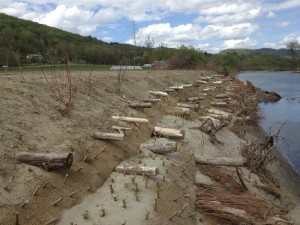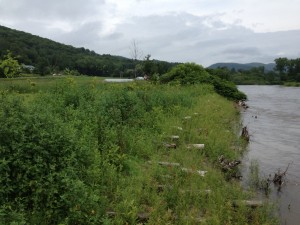You are invited to help the White River Partnership, Vermont River Conservancy, and Town of Sharon build a river access trail on Sunday, June 11 from 2-4pm. The event will be at the new Broad Brook Access in Sharon.
Volunteers should meet at the Broad Brook Cemetery (1106 River Road) and dress to get dirty in long sleeves, long pants, and closed-toed shoes. Gloves, loppers, shovels, pick-mattocks, and light snacks will be provided – feel free to bring your own tools if you have them.
The Broad Brook Access is Sharon’s newest river access site located just downstream of the Broad Brook confluence with the White River. This 10-acre field, located on both sides of the Broad Brook Cemetery, was recently acquired from the landowner by the Vermont River Conservancy; conserved with a permanent easement protecting open space and public access; and donated to the Town of Sharon in March 2017.
The site has long been used for informal fishing access to the mouth of Broad Brook, which is one of the most important trout spawning streams in the lower White River. The June 11 event will build a river access trail through the existing riparian buffer to insure safe, reliable access for fishermen, paddlers, tubers, and more. Formalizing river access also allows the Broad Brook Access to be added to the online White River Water Trail map, an emerging network of publicly-accessible recreation sites along the White River.
The June 11 event is funded by a Vermont Community Foundation grant, and is part of the WRP’s Second Sunday Event series – 5 opportunities to get involved in the WRP’s work to improve the long-term health of the White River and its watershed! For more information, follow this link.
News
Posted: August 1, 2017 by wrp_admin
Monitoring White River crayfish
Crayfish capture people’s attention: they are abundant, yet secretive and somewhat elusive, and just the right amount of scary to pick up. For all of these reasons, they have been a staple of the White River Partnership’s watershed education program since its inception in 2010.
Through the WRP crayfish unit, students and teachers learn about the important role crayfish play in the river’s food web and how the food web might be impacted by the proliferation of non-native crayfish species found in many parts of the watershed. Students also learn how to identify White River crayfish species and put those skills to use out at the river. It’s pretty clear that students love looking for crayfish in the name of science!
Another exciting aspect of the WRP program is that the field data collected by students doesn’t just end up on a shelf. Instead it is shared with Vermont Department of Environmental Conservation scientists who use the data to enhance their understanding of crayfish distribution throughout the state. The WRP program also serves as an early-detection system since the state is constantly on the lookout for the arrival of new crayfish species. The 2017 data sharing component is being funded by a generous grant from the state’s Grant-In-Aid program.
Follow this link to learn more about crayfish and other WRP watershed education units.
Posted: June 6, 2017 by wrp_admin
Help build a river access trail
You are invited to help the White River Partnership, Vermont River Conservancy, and Town of Sharon build a river access trail on Sunday, June 11 from 2-4pm. The event will be at the new Broad Brook Access in Sharon.
Volunteers should meet at the Broad Brook Cemetery (1106 River Road) and dress to get dirty in long sleeves, long pants, and closed-toed shoes. Gloves, loppers, shovels, pick-mattocks, and light snacks will be provided – feel free to bring your own tools if you have them.
The Broad Brook Access is Sharon’s newest river access site located just downstream of the Broad Brook confluence with the White River. This 10-acre field, located on both sides of the Broad Brook Cemetery, was recently acquired from the landowner by the Vermont River Conservancy; conserved with a permanent easement protecting open space and public access; and donated to the Town of Sharon in March 2017.
The site has long been used for informal fishing access to the mouth of Broad Brook, which is one of the most important trout spawning streams in the lower White River. The June 11 event will build a river access trail through the existing riparian buffer to insure safe, reliable access for fishermen, paddlers, tubers, and more. Formalizing river access also allows the Broad Brook Access to be added to the online White River Water Trail map, an emerging network of publicly-accessible recreation sites along the White River.
The June 11 event is funded by a Vermont Community Foundation grant, and is part of the WRP’s Second Sunday Event series – 5 opportunities to get involved in the WRP’s work to improve the long-term health of the White River and its watershed! For more information, follow this link.
Posted: April 3, 2017 by wrp_admin
Volunteer willow harvest event
The WRP is seeking volunteers to harvest live willow stakes on Sunday, April 9 from 2-4pm. The event is at Hurricane Flats Farm in South Royalton (975 South Windsor Street).
Volunteers should dress to work in wet and muddy conditions. The WRP will provide gloves, a few loppers, and light snacks – feel free to bring your own loppers if you have them.
Willows are native shrubs that grow along Vermont’s rivers. Live, dormant willow stakes that are 18-20” long and ½-1” in diameter can be pounded into the face of riverbanks where they will set roots and grow quickly. WRP volunteers will plant the willow stakes harvested on Saturday along the White River in Bethel and Granville this spring.
The WRP plants willows in the face of riverbanks and other native trees along the top of riverbanks to increase benefits to both the river and also to property owners. In the short-term fast-growing willows planted on riverbanks help stabilize soils while other vegetation takes hold. Over time the willow roots intertwine with roots of native trees planted along the top of the riverbanks, creating a dense underground network that makes the riverbank more resistant to erosion. Above ground the willows and other native trees improve water quality by filtering pollutants out of water running through the vegetation; improve habitat by providing food and cover for fish and wildlife; and reduce flood damages by slowing flood waters and capturing debris.

The WRP depends on volunteers to help us plant willows and other native trees along the river each spring. Stay tuned for opportunities to help plant 3,000 stems along the White River in early-May!
Photo caption: The photos were taken 2 months apart at the WRP’s Hurricane Flats Farm streambank restoration project: in May 2013 (after planting willows) and in July 2013 (after the willows set roots and sprouted).